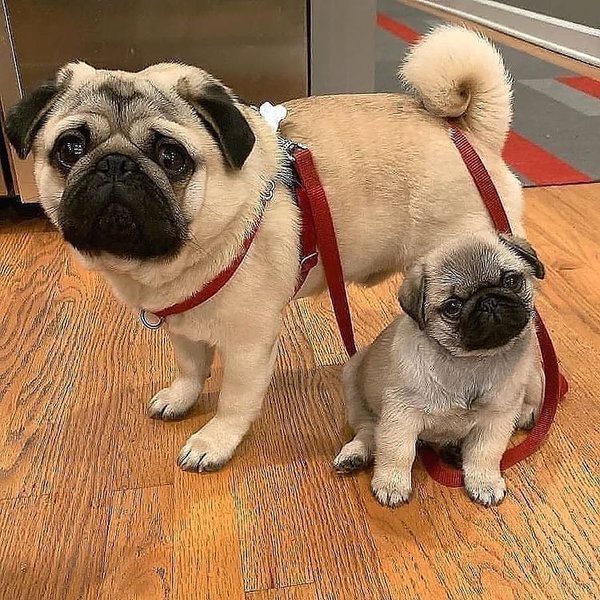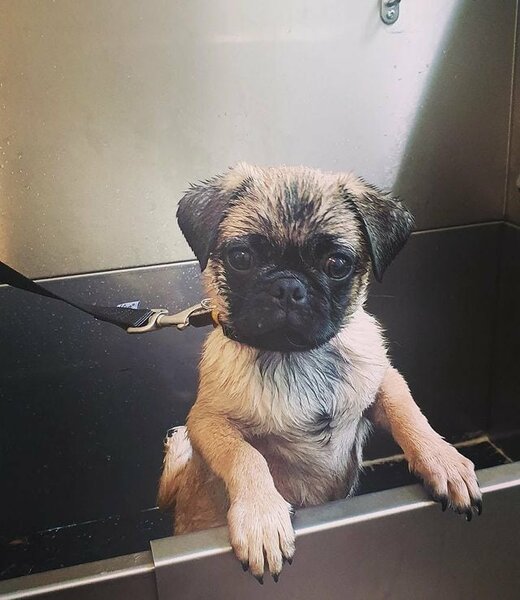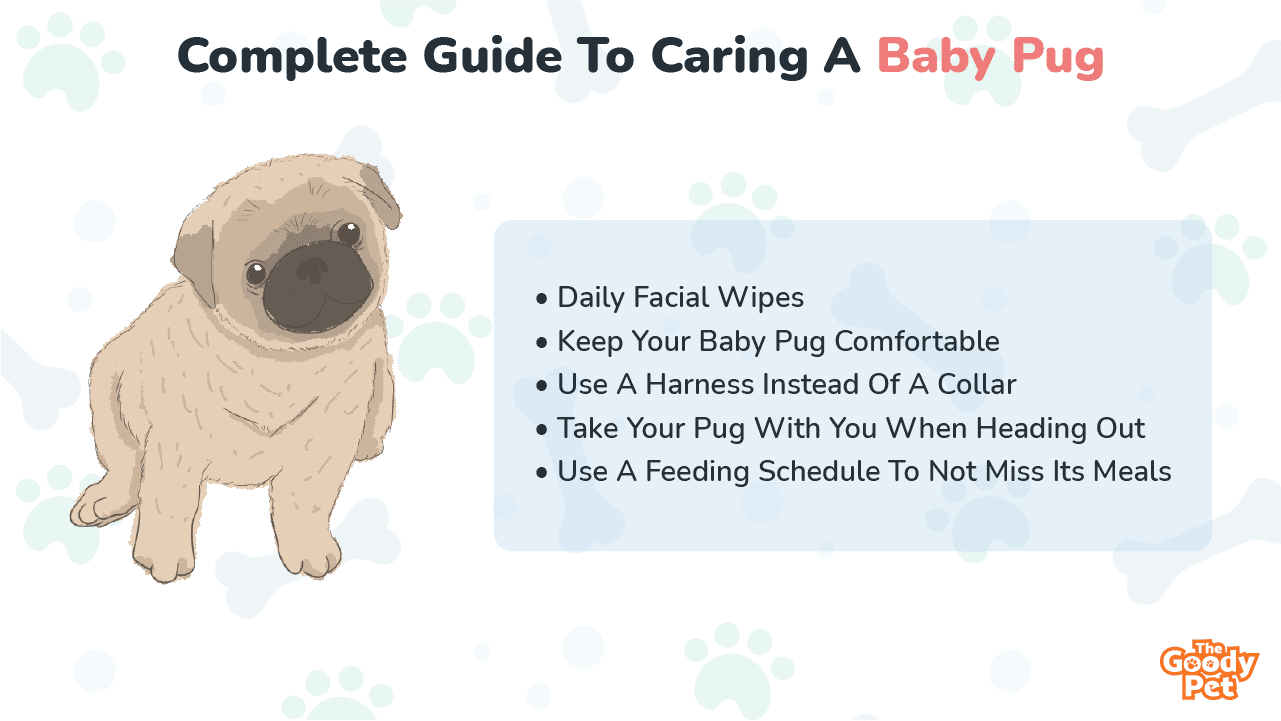When I picked my Baby Pug from the breeder two years ago, I was delighted to finally own the cute dog with a symmetrical and perfect muscular body. But little did I know that this little furry friend also came with a ton of care needs.
Baby Pugs are delicate at birth. They are born deaf, blind, toothless, and unable to move on their own. This implies a lot of care from their mother and breeder for the first 7 weeks before the caring role is passed on to the owner at 8 weeks.
Once you bring your Baby Pug home, a lot of your pup’s care needs are similar to other breeds. But several other Pug care needs are defined by his birth limits and breed proneness to certain conditions. This article is a complete guide for meeting these needs, so your Baby Pug can grow healthy and happy.
Is It Easy To Take Care Of A Pug?

So you have finally brought home your 8-week-old Baby Pug and, as a first-time owner, you’re wondering how to take care of your Baby Pug.
It’s important to know from the onset that some breed characteristics call for special care for your Baby Pug.
Here’s an overview of some of the areas you’ll need to focus on:
Use A Harness, Not A Collar
Pugs are a brachycephalic breed. This means they have a shortened nose and skull with the risk of difficulty in breathing, heaving, exercise intolerance among other issues. The use of harnesses can help lower such risks encountered.
Since the collar sits on your Pug’s neck and can compromise your pet’s airways, it is advisable to use a harness when walking your dog.
Daily Facial Wipes
The Pug’s facial folds have an element of appeal. But they can also be a health hazard if they accumulate dirt and skin excretions.
It is recommended that you use medicated grooming wipes daily to clean your Baby Pug’s facial folds. Consult your pup’s vet or groomer for advice on safe grooming wipes.
Keep Your Baby Pug Comfortable
As a brachycephalic dog breed, Pugs are unable to properly breathe and provide oxygen for their body to work on regulating its core temperature.
It is your role as a responsible parent to ensure your Pug is warm in a sweater during cold winters and well hydrated to help your pet stay cool in hot summers.
Also, avoid outdoor walks or activities in the hottest hours of the day.
We will be discussing with greater detail other key areas of Baby Pug care in the subsequent sections.
What Food Is Best For Pug Puppies?
In Pugs, diet and weight go hand-in-hand.
Pugs Weight
Normally, both male and female Pugs will grow to a maximum weight of 14 to 18 lbs.
In the first weeks, Pugs add on weight extremely fast.
At 8 weeks, for example, they will typically weigh between 2 to 4 lbs. This fast weight-gain means attentive monitoring of what and when your Baby Pug eats.
Pugs Eating Schedule
Pugs are food lovers and so prone to obesity if a healthy diet is not ensured and their eating schedules kept under control.
Consider the feeding schedule below for your Pug puppy. Note that this serves only as a guideline that you should confirm with your dog’s vet, depending on your pup’s needs.
- Age: 8 weeks to 3 months
Meal count: 4
Time: 7am / 11am / 3pm / 7pm - Age: 3 to 6 months
Meal count: 3
Time: 8am / 1pm / 6pm - Age: 6 to 12 months
Meal count: 2
Time: 9am / 5pm
Your Pugs’ meals should be high-quality healthy food and so should be any treats given between meals.
Best Food For Pug Puppies
Choose a reliable commercial dog food formulation with the necessary nutrients for proper growth and health.
You can also opt for fresh healthy food from a commercial dog kitchen. The Pet Plate kitchen is recommended. These dog-food experts have vet-formulated, nutritionally balanced, and highly palatable dog food that will be delivered to your doorstep. And you have a choice for chicken, beef, turkey, and lamb.
A hip and joint supplement such as Doggie Dailies Glucosamine is also recommended. This not only gives Glucosamine and Chondroitin but has other active and vital ingredients for your Pug’s bone and joint health. Besides, they are a tasty treat between meals.
How Much Attention Do Pugs Need?
Pugs are lap dogs originally bred for companionship.
They require a lot of attention and, therefore, love to cuddle and are happy following you everywhere or sitting on your lap when you are home.
Since they love being around you, Pugs will suffer when left home alone. This is one reason they will tend to whine and cry a lot.
But your Pug crying could also communicate anxiety, frustration, or pain.
Their need for attention also makes them prone to boredom and separation anxiety when left alone.
To manage your Pug’s attention needs consider the following options:
Take Your Baby Pug With You When You Go Out
If you are not going to work and the nature of your errand can allow it, take your Pug puppy with you when you go out. Pugs are tiny and easy to bring around. Besides, they will follow you faithfully.
Consider A Substitute Companion
If you have to go to work daily and your Pug will be home alone, consider hiring someone to be with your dog when you are away.
Ensure that a connection has been created between your Pug and the substitute before proceeding to leave your puppy with them.
You can also consider using technology that allows you to monitor, give treats, and stay connected with your Pug when you are away. The Furbo Dog Camera is a perfect option for the job.
Other Ways
Avoid ritualizing departures and re-entries and make separation part of socialization training when your Pug is still a puppy.
Training Tips For Pug Puppies
The Pug dog is ranked 108 out of 138 for obedience intelligence. In dog training, that means you’ll need to repeat commands many times before your Baby Pug can learn them.
The Pug is also known to be stubborn, and this could make training more difficult and require plenty of patience.
But your Pug’s friendly nature and the desire to please both work in favor of achieving good training for your Baby Pug.
To achieve the best results from your Pug’s training, consider the following tips:
- Pugs have a short attention span, so keep the training sessions short (15 to 20 minutes) and recap training commands frequently.
- Teach your dog a focus command such as “Attention!” early in the training so you can use it to obtain your pup’s concentration.
- Consider training your dog in the morning hours when his energy is still high and focus is obtained more easily.
- As friendly companions, Pugs can be overly sensitive to punitive treatment. So, never shout at your Pug during training as this will make them frightened of you and no learning will be achieved.
- Do not fall for your Pug’s “begging eyes”. Giving in to their whim will only make them more difficult to train and heed commands.
- Involve persons who interact with your Pug in the training process so your dog learns to also take commands from them. This could be family members or a substitute caregiver.
- If it’s not working with you, consider a professional trainer, or go for obedience classes.
Grooming Tips For Pug Puppies

Pugs can be prone to skin and eye infections if not kept clean. Besides, they are heavy shedders and require consistent grooming.
Focus on these aspects when grooming your Pug.
Monthly Baths
A bath a month is a good schedule for your Pugs heavy coat. Baths will control shedding and get rid of loose fur.
Also, Pugs may be prone to bad odor even when they don’t look dirty. This may be caused by sweat or dirt in their skin folds or yeast between their paws, so a bath is a good care routine.
Since your Pug has sensitive skin, use a mild shampoo with a pH of 6.5 to 7.5. This should also check body odor.
Daily Eye And Face-Folds Cleaning
Your Pug’s eyes are large and slightly bulging so they can easily pick dust or get scratched, especially while feeding.
To prevent scratches, place your pet’s feeding bowl on an elevated position.
Also, clean their eyes off the salty fluids and their face folds daily with safe medicated grooming wipes.
Regular Fur Brushing
To keep your Pug’s heavy shedding under control, brush your puppy’s coat once every week and daily for an adult Pug.
Even if you do not notice it, plenty of loose furs are trapped in your dog’s coat and needs to be eliminated before ending up on your clothes or couch.
Use a brushing tool that penetrates your Pug’s thick coat for best results.
You can also consider using grooming gloves to stimulate your dog’s natural skin processes while you get rid of loose fur.
Related Questions
What Age Is A Pug Full Grown? Your Pug is an adult by the age of 1 but may still show puppy tendencies at this age. By now, your Pug has 90% of his full height and 80% of his full weight. Its growth can still occur between 1.5 to 7 years. Its muscular body is formed in this period, which is also your pet’s prime age.
Do Pugs Like To Sleep With Their Owners? As the cuddly dogs that they are, Pug’s love the warmth of their owner’s bed. This may also be accentuated by their need to keep warm, which they are not always able to achieve naturally by themselves. Whether letting your Pug sleep with you is right or not is all up to your decision.
Does My Baby Pug Have Down Syndrome? Down syndrome is a congenital defect caused by partial or complete duplication of chromosome 21 in humans. Dogs have different chromosomal makeup. Your dog may have a canine-chromosomal defect with symptoms similar to Down syndrome in humans. Some canine conditions that mimic Down syndrome include Congenital Hypothyroidism, Congenital Hydrocephalus, Pituitary Dwarfism, and Portosystemic Shunt.





